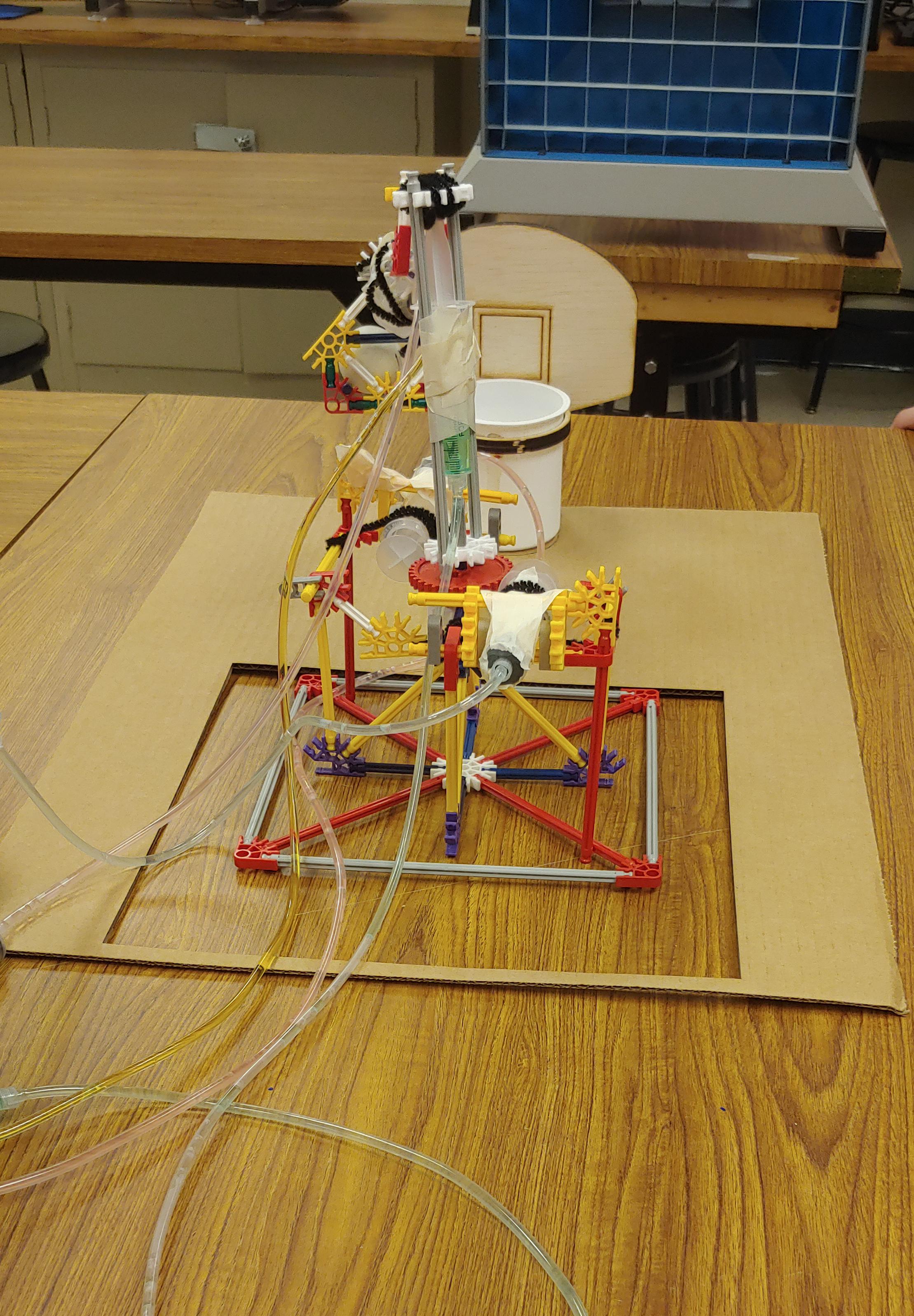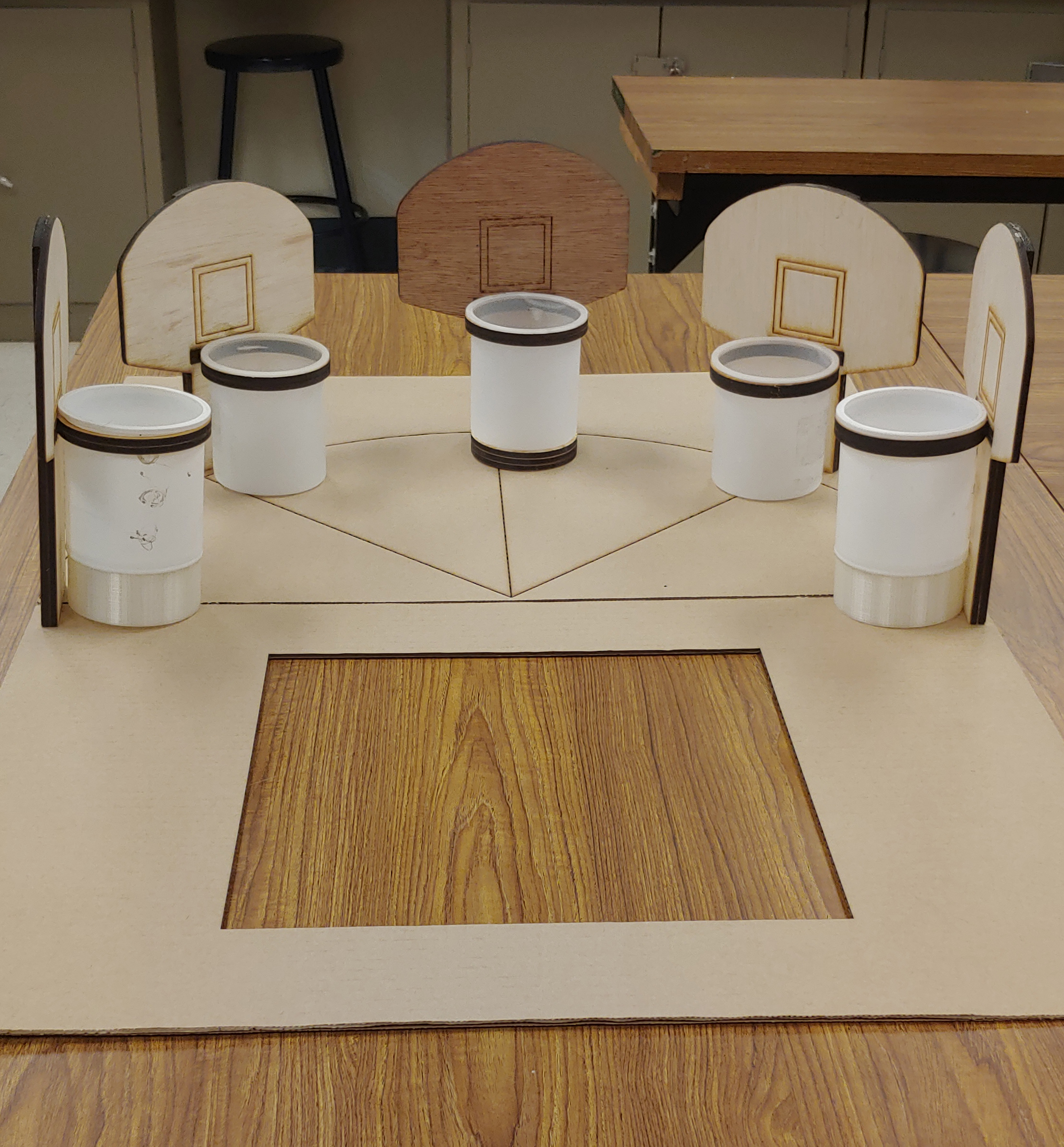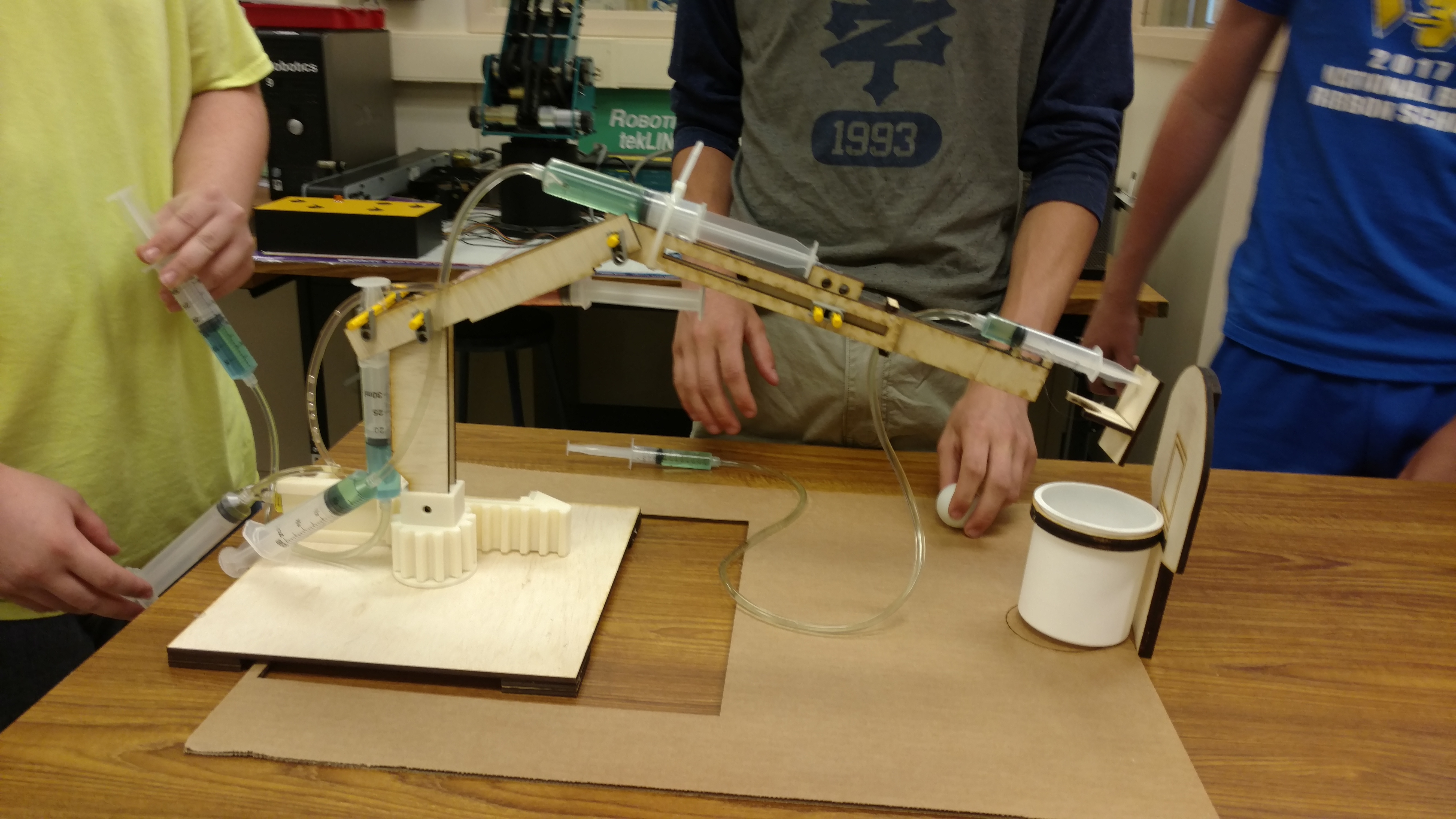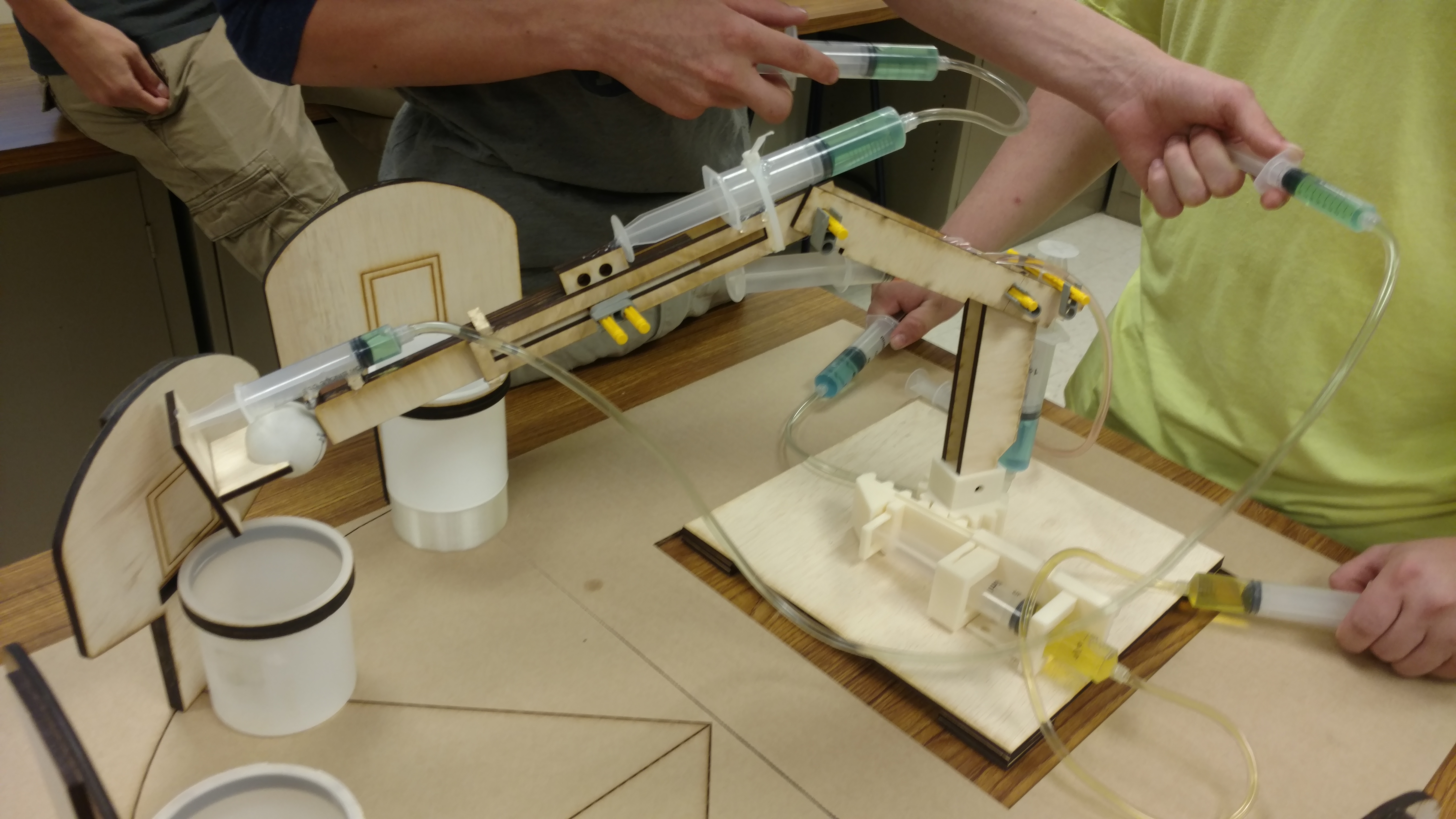Hoop Shoot Challenge
Introduction
Hydraulics is the branch of science and technology concerned with the conveyance of liquids through pipes and channels, especially as a source of mechanical force or control. Fluid mechanics provides the theoretical foundation for hydraulics, which focuses on the applied engineering using the properties of fluids. In fluid power, hydraulics are used for the generation, control, and transmission of power by the use of pressurized liquids. Hydraulic topics range through some parts of science and most of engineering modules, and cover concepts such as pipe flow, dam design, fluids and fluid control circuitry and pumps.
Mechanical advantage is a measure of the force amplification achieved by using a tool, mechanical device or machine system. Ideally, the device preserves the input power and simply trades off forces against movement to obtain a desired amplification in the output force. Machine components designed to manage forces and movement in this way are called mechanisms. An ideal mechanism transmits power without adding to or subtracting from it. This means the ideal mechanism does not include a power source, is friction-less, and is constructed from rigid bodies that do not deflect or wear. The performance of a real system relative to this ideal is expressed in terms of efficiency factors that take this into account
Problem
Design and engineer a mechanical device that is powered by hydraulic (syringe and water) that includes levers and moving parts that will propel a ping pong ball to complete the 2 levels of the “Hoop Shoot Challenge”. The final product for this challenge will be laser cut from wood. It is also possible to 3-D print parts as needed but the main body of the device will be processed on the laser engraver. All prototyping will be done utilizing K’nex and cardboard. The majority (70%) of the final product must be main from 3-D printed and laser cut items. The students will also be given a 24 gear package but are encourage to design their own gears.
Limitations and Considerations
1. The device should be no bigger than 12 inches wide x 12 long x 12 high with all axis compacted.
2. The power from the syringes and water will be used to maneuver the mechanics of your device. You cannot aid this in any way. You may load the ping pong ball into the devises gripper or holding mechanism.
3. No item may be launched or thrown along with the ping pong ball. The ball must be the only item that leaves the device.
4. All groups will be given 6 - 30 ml, 3 – 20 ml, and 3 - 12 ml syringes. You do not have to use all of them but you can only use your 12. Tubing will be supplied on an at need basis. It is permissible to trade in your 20 and 10 for 30 ml syringes.
5. Other materials available on request: string, pipe cleaners, round wooden dowel, binder clips, paper clips, rubber bands, craft wire, glue (hot and wood), zip ties, and brass paper fasteners (1/8 hole diameter). Any other materials that are not listed or laser cut and 3-D printed must get instructor approval prior to use.
6. The material thickness for the wood to be cut is 0.20 inches and the cardboard is 0.177 inches. There is no cubic inch limitation for the 3-D print material but try to be conservative. Limit wall thicknesses to 0.063 inches to 0.125 maximum.
7. T-slots for the syringe plunger and brackets for the body may be the best application for fastening the hydraulic cylinders in place. It is permissible to have multiple location to place the hydraulic cylinders that way your device is adjustable for the various challenges.
8. Slots placed in targeted areas of your device can change or limit the range of motion in a calculated manner.
Evaluation
|
The Lay Up - # made in a 2 minute time frame (Based was class best) = 10 pts = ____________ - Your results were in the top 20% of the class – 10 pts - Your results were in the top 40% of the class – 9.5 pts - Your results were in the top 60% of the class – 9 pts - Remainder of Participants with 3 successful makes – 8.5 pts - Remainder of Participants with 2 successful makes - 8 pts - Remainder of Participants with 1 successful make – 7.5 pts - Does not make any at all – 0 pts
|
Around the Horn – 5 shots placed in a semi-circle in the fastest time possible
(Based was class best) = 10 pts = ____________
- Your results were in the top 20% of the class – 10 pts - Your results were in the top 40% of the class – 9.5 pts - Your results were in the top 60% of the class – 9 pts - Remainder of Participants with 3 successful makes – 8.5 pts - Remainder of Participants with 2 successful makes - 8 pts - Remainder of Participants with 1 successful make – 7.5 pts - Does not make any at all – 0 pts
|
|
CATEGORY |
5 - Advance |
4 - Proficient |
3 or 2 - Basic |
1 or 0 - Below Basic |
Score |
|
Design / Creativity/ Complexity of the Device |
Extremely creative and thoughtful use of materials available to them. Design showed features that require extensive thought and consideration. Product meets all parts of challenge. |
Very creative and thoughtful use of materials available to them. Design showed features that require some thought and consideration. Obvious that a considerable amount of time was spent designing and producing the device. |
Design is somewhat creative in using materials available to them. Obvious that not much time or thought was spent planning, designing and producing the device. Product may only meet part of the challenge. |
Design is not original and lacks luster. Little or no time was spent in the development of the idea. Design is not successful in meeting the challenge |
|
|
Mechanical Design / Function of the Fluid Power System |
The system is designed to provide a mechanical advantage with all but one axis movements and preforms effectively in all 5 of the suggested movements |
The system is designed to provide a mechanical advantage with all but two axis movements and preforms effectively in 4 of the 5 of the suggested movements |
The system is designed to provide a mechanical advantage with only one or two axis movements and preforms effectively in 2 or 3 of the 5 of the suggested movements |
The system is designed to provide a mechanical advantage with only one axis movements and preforms effectively in only one of the 5 of the suggested movements |
|
|
Mechanical Design of your Devices Action |
Streamlined and extremely creative use of parts to create a remarkably functioning mechanism following various scientific principles. |
Appropriate and creative use of parts to create a reasonably functioning mechanism. |
Inefficient or standard use of parts to create a mechanism that does function but with limitations. |
Mechanism does not function at all or does with major flaws in the mechanics. The device does not utilize an appropriate scientific principles. |
|
|
Quality of General Construction of the Device |
Great care taken in construction process so that the structure is neat, attractive and follows plans accurately with room for reasonable design modifications. |
Construction was careful and accurate for the most part, but 1-2 details could have been refined for a more attractive and functioning product. |
Construction followed the plans, but 3-4 details could have been refined for a more attractive and functioning product. |
Construction appears careless or haphazard. Many details need refinement for a functioning or attractive product. |
|
|
Structural Design - Integrity / Significance |
Structure is extremely sturdy and functions extraordinarily well, holding up under atypical stresses. |
Structure is very sturdy and functions very well, holding up under atypical stresses. |
Structure is somewhat sturdy and functions pretty well, but deteriorates under typical stresses. |
Fatal flaws in function or sturdiness or complete failure under typical stresses. |
|
|
Effective / and Efficient Use of Materials |
All materials were used extremely well with no waste. Appropriate materials were selected and creatively modified in ways that made them even better |
All materials were used well with little waste. Appropriate materials were selected and there was an attempt at creative modification to make them even better. |
All materials were used satisfactory but there is noticeable waste. Proper materials were selected but not used in a very creative manner. |
There is an extreme amount of waste of materials. Inappropriate materials were selected and contributed to a product that performed poorly. |
|
|
Timeliness and overall effort |
The project was completed early or on time, showing extraordinary effort. |
The project was completed on time, showing a very reasonable amount of effort. |
The project was completed on time, showing some flaws in effort of effort. |
The project was not completed on time, the student did not use class time appropriately or put forth an adequate effort. |
|
Engineering Design Notebook - The students are required to have one journal entry per week that include: brainstorming, construction notes and progress, encountered problems and solutions, and areas of concern.
Assessment Instrument–Engineering Design Process Worksheet Rubric
|
Category |
Below Target (0 points) |
At Target (1 point) |
Above Target (2 points) |
Score |
|
Generating Ideas |
Contributes ideas that produce incomplete sketches and/or does not present a concept |
Produces marginally accurate pictorial sketches of design concepts with no parts labeled |
Produces accurate pictorial and sketches of design concepts that are drawn in a manner that they are easy to understand with necessary parts labeled. |
|
|
Exploring Possibilities |
Inadequately analyzes the pluses and minuses of a variety of possible solutions |
Satisfactorily analyzes the pluses and minuses of a variety of possible solutions |
Thoroughly analyzes the pluses and minuses of a variety of possible solutions |
|
|
Selecting an Approach |
Selection of solution is not based on consideration of criteria and constraints |
Selects a promising solution based on criteria and constraints |
Selects a promising solution based on a thorough analysis criteria and constraints |
|
|
Making a Model or Prototype |
Prototype meets the task criteria to a limited extent |
Prototype just meets the task criteria |
Prototype meets the task criteria in insightful ways |
|
Resources:
eGFI - March Madness STEM Resources http://teachers.egfi-k12.org/march-madness-stem-resources/
Mechanical Arm http://jefenry.com/main/MechanicalArm.php#plans
Arm of Achelous- Tutorial https://www.youtube.com/watch?v=lhOF6cViZ4Q
Easy hydraulic machine https://www.youtube.com/watch?v=9JDFseoAaNU
Hydraulic Robot https://www.youtube.com/watch?v=6xljw4yoe9A
Easy K'nex Pneumatic Crane https://www.youtube.com/watch?v=Fwsu_pGPsSo
Hydraulic robotic arm with syringe https://www.youtube.com/watch?v=6kk335WDglE
Photos:

Prototyping for The Lay Up Challenge

Around the Horn Challange

Student Example

Student Example 2
Teaching Strategies
StartSOLE
StartSOLE is a simple inquiry-based approach that can be implemented in a single class period with minimal constraints and serves as an excellent addition or supplement to this lesson. If you'd like to use one of these suggested questions to encourage students to dig deeper or help prepare them for this activity click on a link below to setup your StartSOLE lesson:
- How can we use quadratic functions to solve real life problems?
- What is the connection between gravity, energy, and motion?